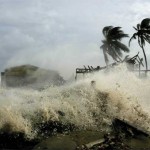Disastrous floods, heatwaves, storms and droughts are becoming more frequent because of climate change, and will continue to do so.
Scientists say the world can no longer ignore the link between climate change and extreme weather events, and they are urging countries to face up to the growing risks ahead.
New Zealander Kevin Trenberth, who heads the climate-analysis section at the National Center for Atmospheric Research in Colorado, said events of the past 18 months had been extraordinary. “It’s as clear a warning as we’re going to get about prospects for the future.”
Last year was the warmest on record and that warming was directly related to increases in carbon dioxide in the atmosphere, he said. It brought with it devastating floods in Pakistan and a heatwave in Russia, which resulted in riots around the world because of increased food prices.
Subsequent floods in Sri Lanka, Brazil and Queensland also brought deaths on a huge scale, and Dr Trenberth said scientists were now considering how such extreme events were linked.
Although some aspects of extreme weather were due to natural variation, global warming was now contributing too, with disastrous consequences. “There’s this 5-10 per cent contribution that may be thought of as the straw that breaks the camel’s back.”
The world would experience less snow and more rain, more floods, more heatwaves and consequent wildfires, and more storms featuring hurricanes and tornadoes.
Professor Lionel Carter, of Victoria University’s Antarctic Research Centre, said the effects were being seen on New Zealand’s doorstep, with the Tasman Sea getting warmer, and that warming shifting south.
Antarctica was losing mass, and the West Antarctic ice sheet in particular was causing concern as much of it was below sea level. A change to its mass could see the ice sheet lift off and raise the sea level by three to five metres.
This year was likely to be significant for extreme events such as floods, tornadoes and droughts, he said.
Dr Trenberth said increased temperatures had led to more water staying in the atmosphere. “What we are seeing throughout the world is when it rains, it pours.”
Over the oceans there was now 4 per cent more water vapour than in the 1970s, and sea surface temperatures had increased by about 0.55 degrees Celsius.
“The environment in which all storms form now is different to 30 or 40 years ago because of climate change.”
Professor Martin Manning, of Victoria’s Climate Change Research Institute, said humans were a primary driver for climate change, and the question now was how we dealt with the problem.
Insurance companies were beginning to recognise the trends in extreme weather and pay attention. “They’re getting extraordinarily concerned. They don’t really think what we’re doing at the moment is risk management.”
The world had “pushed way past” the point where local adaptations to climate change were going to be enough, as patterns of extreme events were too widespread. “We’re starting to see global risks being dealt with. It’s a global problem.”
– More… ➡
